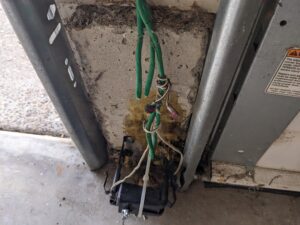Any place where two or more wires are “spliced” (joined) together has the potential to be a problem.

Bad splices can be very sneaky. The don’t always fail completely. Instead, the wires end up essentially laying on top of each other, making contact until some slight vibration or movement (we are talking about microscopic changes here) causes them to come apart. Even changes in temperature and humidity can be enough to break the connection.
The result is loss of power to the safety sensors, which leads to your garage door refusing to close. It can be a constant problem, or may come and go at random.
It is easy to mistake a bad splice for an alignment problem (especially if you have a LiftMaster/Chamberlain/Craftsman opener), so be sure to do your troubleshooting in the right order.
Finding the Splice
Most homes built before 1993 were never pre-wired for safety sensors so the wire is stapled to the outside of the wall or framing. While you can be pretty confident that wires that are hidden inside the wall have not been spliced, the same cannot be said for exterior wiring. Trace the wires and you may find one or more splices that could be the source of your problem.
Most of the time the only splices you will find are near the safety sensors where they join the pre-wiring that runs through the wall.
There may be another splice near the opener. Sometimes the electrician doesn’t leave a long enough wire tail sticking out of the ceiling. In this case you have to add to it in order to reach the wiring terminals on the side of the motor. Also, if the pre-wiring is extremely thick, a length of bell wire may be spliced to it in order to reduce the wire down to a size that will fit the terminal.
Next: Checking the Splice